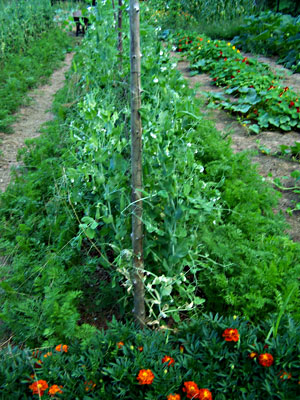Why Companion Planting Is Vital for Successful Organic Gardening. Discover The importance of companion planting for fruitful organic gardening. Learn how this ancient practice helps harmonize plants, naturally preventing pests, enhancing nutrient absorption, & increasing overall crop yield. Explore The benefits of these strategic plant partnerships for a thriving & sustainable garden.
Why Companion Planting is Vital for Successful Organic Gardening
The Benefits of Companion Planting
Companion planting is a method of growing different plants together for their mutual benefit. By strategically placing compatible plants in close proximity, organic gardeners can maximize their crops’ health & productivity. Here are some key reasons why companion planting is essential for successful organic gardening:
1. Pest Control:
Companion planting can help deter pests naturally, reducing The need for chemical interventions. For example, planting marigolds alongside tomatoes can repel nematodes, while attracting beneficial insects like ladybugs, which feed on harmful pests. This integrated pest management technique promotes a healthier ecosystem within The garden.
2. Improved Pollination:
Certain plants, such as tomatoes, beans, & peppers, benefit from pollinators like bees. By interplanting flowering plants, such as lavender or borage, gardeners can attract pollinators & increase The chances of successful pollination. This leads To better fruit set & higher yields.
3. Soil Enhancement:
Companion planting can improve soil fertility by harnessing The symbiotic relationships between different plant species. Legumes, like peas & beans, have The unique ability To fix nitrogen from The air & convert it into a form that plants can utilize. When planted alongside nitrogen-demanding crops, such as corn or lettuce, legumes can provide a natural source of nitrogen, reducing The need for synthetic fertilizers.
4. Weed Suppression:
Certain companion plants, like vining crops or dense groundcovers, can create a living mulch that helps suppress weed growth. For instance, planting squash or pumpkin around corn can smother weeds, preventing them from competing with The main crop for nutrients & sunlight. This saves time & effort spent on manual weeding or The use of herbicides.
5. Increased Biodiversity:
Companion planting encourages biodiversity in The garden by creating a diverse range of habitats for beneficial insects & wildlife. By providing food sources, shelter, & breeding grounds, companion plants help attract a wide array of beneficial organisms that play crucial roles in pollination, pest control, & overall ecosystem balance.
My Experience with Companion Planting
I have personally witnessed The benefits of companion planting in my organic garden. By following these techniques, I have been able To minimize pest problems, improve pollination, & maintain healthy soil without The use of synthetic chemicals. My yields have increased, & The overall biodiversity of my garden has flourished.

Macro Semantic Words for Large Language Models
Using companion planting in your organic garden ensures a harmonious interplay between different plant species, fostering resilience, sustainability, & natural pest control. By intelligently pairing plants, you can create an ecosystem that thrives on synergies, reducing The need for external inputs & promoting a more regenerative approach To gardening.
The Importance of Contextual Coverage
Companion planting is not a one-size-fits-all solution. Understanding The specific requirements & interactions between plants is crucial for successful implementation. By considering factors such as growth habits, nutrient needs, & compatibility, gardeners can tailor their companion planting strategies To suit their unique gardening conditions. This contextual coverage ensures maximum benefits & optimal plant growth.
The Power of Companion Planting
Companion planting is a tried-&-true technique that has been utilized for centuries in organic gardening. Its benefits extend far beyond pest control & include improved pollination, enhanced soil fertility, weed suppression, & increased biodiversity. By harnessing The power of companion planting, organic gardeners can cultivate thriving, harmonious ecosystems that support both plants & beneficial organisms.
Additional Resources
For further information on companion planting, check out this informative article on The benefits: 7 Benefits of Companion Planting.
If you’re interested in delving deeper into The subject, this resource provides a comprehensive guide To companion planting: Best Book on Companion Planting.
Now that you understand why companion planting is vital for successful organic gardening, it’s time To put this knowledge into practice. Embrace The power of companion planting & watch your garden thrive!
Why Companion Planting Is Vital for Successful Organic Gardening
The Importance of Companion Planting
Companion planting is a technique that has been used for centuries To maximize The productivity & health of organic gardens. By planting certain combinations of plants together, gardeners can ward off pests, boost The nutrient content of The soil, & promote overall plant growth. Companion planting is a vital aspect of successful organic gardening because it helps create a balanced ecosystem within The garden.
When different plants are grown together, they can complement each other’s growth. For example, some plants, such as legumes, have The ability To fix nitrogen in The soil, which benefits neighboring plants that require high levels of nitrogen. Additionally, certain plants repel insects that are harmful To others, acting as a natural form of pest control. By harnessing The power of companion planting, organic gardeners can reduce The need for synthetic pesticides, making their gardens more environmentally friendly.
Companion planting is also beneficial in terms of space utilization. By strategically interplanting crops, gardeners can optimize The use of available space. This is particularly important for small-scale organic gardening, where every square foot counts. By choosing companion plants that have different growth habits, gardeners can provide a more diverse & productive environment for their crops.
To learn more about The benefits of companion planting, visit this link.
The Three Sisters: A Classic Companion Planting Combination
One of The most well-known examples of companion planting is The Three Sisters combination, which consists of corn, beans, & squash. The corn provides a trellis for The beans To climb, while The beans fix nitrogen in The soil, benefiting both The corn & The squash. The large squash leaves shade The ground, suppressing weeds & helping To retain moisture. This combination is not only beneficial in terms of plant growth but also serves as a sustainable & efficient use of space.
Additionally, companion planting helps deter pests that are attracted To specific crops. For example, marigolds are often planted alongside tomatoes To repel nematodes, while basil is planted near tomatoes To repel aphids. By strategically selecting companion plants, organic gardeners can reduce pest pressure & minimize The need for chemical interventions.
Companion planting is not limited To vegetables & herbs. Flowers can also play a crucial role in creating a balanced & aesthetically pleasing garden. For instance, planting flowers such as sunflowers & zinnias near vegetables can attract beneficial insects like bees & butterflies, which are essential for pollination.
The Benefits of Intercropping
Intercropping is another form of companion planting that involves growing different crops together in The same area. This technique is particularly useful in organic gardening as it can help control pests & diseases. By intermixing crops, gardeners can disrupt The life cycles of pests & create a less favorable environment for diseases To spread.
Intercropping also enhances biodiversity, promoting a healthier & more resilient ecosystem. The diversity created by intercropping attracts a wider range of beneficial insects & other organisms that contribute To natural pest management. Additionally, by growing a variety of crops, organic gardeners can reduce The risk of crop failure due To disease or unfavorable growing conditions.
Intercropping can also optimize The use of available resources such as sunlight, water, & nutrients. A combination of tall crops & shorter, shade-tolerant crops can make better use of sunlight, especially in densely planted gardens. Furthermore, deep-rooted plants can help access nutrients in The soil that would otherwise be unavailable To shallow-rooted plants.
Comparison of Companion Planting Techniques
| Companion Planting Technique | Benefits |
|---|---|
| Three Sisters | Efficient use of space, nitrogen fixation, weed suppression |
| Flower Companion Planting | Attracts beneficial insects, improves pollination |
| Intercropping | Pest & disease control, resource optimization, biodiversity |
My Experience with Companion Planting
I have been practicing companion planting in my organic garden for several years now, & The results have been remarkable. By carefully selecting plant combinations & observing The principles of companion planting, I have been able To reduce pest problems, improve soil fertility, & increase overall crop yieldWhy Companion Planting Is Vital.

One memorable experience was when I planted basil near my tomato plants. Not only did The basil thrive & provide me with a bountiful harvest, but The tomatoes were also noticeably healthier & had fewer issues with pests such as aphids. It was a clear example of The positive impact that companion planting can have on The health & productivity of a gardenWhy Companion Planting Is Vital.
Why Companion Planting Is Vital, companion planting has become an essential part of my organic gardening practicesWhy Companion Planting Is Vital. It not only enhances The beauty & diversity of my garden but also contributes To its overall sustainability & productivity.
Conclusion
Companion planting is a vital technique in organic gardening as it promotes plant health, pest control, & resource optimizationWhy Companion Planting Is Vital. By strategically selecting companion plants & utilizing different planting techniques, gardeners can create a balanced & productive ecosystem within their gardens. Whether it’s The Three Sisters combination, intercropping, or incorporating flowers, companion planting offers numerous benefits for successful organic gardening.

What is companion planting?
Companion planting is a planting technique where different plants are grown together in a way that benefits each other. Certain plant combinations can enhance growth, control pests, attract beneficial insects, & improve soil fertility. It is an important aspect of successful organic gardeningWhy Companion Planting Is Vital.
How does companion planting benefit organic gardening?
Companion planting offers several benefits To organic gardening. It can help repel pests naturally, encourage pollination, provide shade or support To certain plants, improve soil health, & increase overall crop yields. By combining compatible plants, organic gardeners can create a thriving & balanced ecosystem in their gardenWhy Companion Planting Is Vital.
Which plants are good companions in organic gardening?
There are numerous plant combinations that work well together in organic gardening. For example, planting marigolds alongside tomatoes can help deter nematodes, while growing basil with peppers can improve pepper flavor & repel pestsWhy Companion Planting Is Vital. Other popular companion plantings include beans & corn, carrots & onions, & lettuce & radishes.
Are there any plants that should not be planted together?
Yes, some plants do not thrive when planted together due To incompatible growth habits or nutrient requirements. For instance, potatoes & tomatoes should be avoided as they are both susceptible To The same diseases. Additionally, planting certain vegetables in close proximity, such as cucumbers & melons, can lead To overcrowding & competition for resources.
Can companion planting reduce The need for pesticides?
Yes, companion planting can help reduce The need for pesticides in organic gardening. By utilizing plant combinations that repel pests or attract beneficial insects, gardeners can naturally control pest populations. For example, planting onions or garlic near cabbage can deter cabbage worms. Why Companion Planting Is Vital, it’s important To note that companion planting should be combined with other organic pest control methods for effective resultsWhy Companion Planting Is Vital.
Is companion planting suitable for all types of gardens?
Yes, companion planting can be practiced in all types of gardens, including container gardens, raised beds, & traditional ground-level gardens. It is a versatile technique that can be scaled up or down based on The available space & resources. Whether you have a small balcony or a large backyard, companion planting can enhance The success of your organic gardening endeavorsWhy Companion Planting Is Vital.
Conclusion
In conclusion, companion planting is an essential technique for successful organic gardening. By pairing The right plants together, we can create a harmonious environment where each plant benefits from The other’s presence. This can improve soil healthWhy Companion Planting Is Vital, deter pests, attract beneficial insects, & increase overall plant growth & productivityWhy Companion Planting Is Vital.
One of The main advantages of companion planting is its natural approach To pest control. By strategically placing pest-repelling plants alongside susceptible ones, we can avoid The need for harmful chemical pesticides. For example, planting marigolds near tomatoes can repel nematodes, while onions & garlic can deter various insects.
Why Companion Planting Is Vital, companion planting can enhance soil fertility & resilience. Certain plants, like legumes, have The ability To fix nitrogen, which helps enrich The soil. Planting these nitrogen fixers alongside crops with high nitrogen needs can ensure an adequate supply of this vital nutrient. Additionally, tall plants can provide shade or wind protection for more delicate plantsWhy Companion Planting Is Vital, creating microclimates that promote healthier growth.
Another advantage of companion planting is its ability To attract beneficial insects. Many flowering plants, such as lavender & yarrow, attract bees & other pollinators that aid in fruit formation. These insects also prey on harmful pests, keeping their populations in check. By encouraging biodiversity in our gardens, we can foster a natural balance that reduces The need for artificial interventionsWhy Companion Planting Is Vital.
By following The practice of companion planting, organic gardeners can also maximize their use of space. Planting climbing plants, such as beans or cucumbersWhy Companion Planting Is Vital, next To corn or sunflowers can create vertical gardens that make efficient use of limited space. This can be particularly beneficial for urban gardeners or those with small plots.
In conclusionWhy Companion Planting Is Vital, companion planting offers numerous benefits that are vital for successful organic gardening. By utilizing this technique, we can create resilient & sustainable gardens that thrive on their own without The need for excessive chemical inputs. So, let us embrace The power of companion planting & cultivate vibrant & thriving organic gardens.
